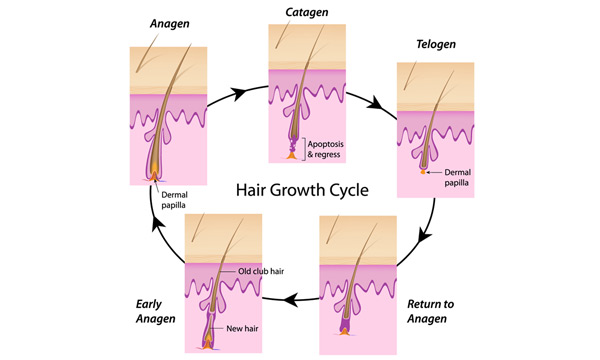Understanding Hair Growth Cycles and Effective Hair Removal
Many people believe that the hair they can see is all the hair they will ever have. However, this is not true, as hair goes through a life cycle timed by genes. The hair growth cycles can vary from a few months to several years and begins when a new dermal papilla is formed at the base of the follicle. The dermal papilla is the blood supply that nourishes the hair.

The Hair Growth Phases
Early Anagen Phase: The beginning stage is called the early Anagen phase. At this stage, the hair is in its growing phase and is nourished by the dermal papilla.
Later Anagen Phase: As the hair grows and becomes stronger, it continues into the later Anagen phase. At this stage, the hair is at its strongest point and the most difficult to permanently destroy.
Catagen Phase: The next phase of the hair growth cycle is the Catagen phase. During this phase, the hair begins to detach itself from the dermal papilla, losing its direct nourishment but still receiving minimal nutrients from surrounding capillaries.
Telogen Phase: When the hair completely detaches from the shrinking dermal papilla and no longer receives nourishment from the surrounding capillaries, it enters the Telogen phase. The hair is simply held in the follicle, which has also shrunken during the process. These hairs naturally shed and fall out with combing or friction.
The Importance of Treating the Right Hair Phase
There are cases where early Anagen hair can be growing below the surface before the Telogen hair on top of it has shed. If only the Telogen hair is treated in the follicle, regrowth will occur because the dermal papilla was not treated. In order for electrolysis to be effective, the dermal papilla, the blood supply, must always be treated.
The time from the Anagen phase to the Telogen phase varies based on two factors: the area of the body and the genetic makeup, including hormonal factors, of each person. As a result, it is important to understand the rate of hair growth on different parts of the body.
Types of Hair: Vellus and Terminal
The body is made of two types of hairs called vellus and terminal. Vellus hair is fine, light-colored hair found on most parts of the body. Terminal hairs are thick, long hairs influenced by the androgenic hormone. Below is a chart detailing the regrowth rate of these hairs on different parts of the body.
Regrowth Time Chart
| Type of Hair | Key F = Female, M = Male | Regrowth Time |
|---|---|---|
| Hairline | F/M | 4-6 Weeks |
| Eyebrows | F/M | 3-6 Weeks |
| Upper lip (Vellus) | F | 7-10 Weeks |
| Upper lip (Terminal) | F/M | 4-6 Weeks |
| Side of Face (Vellus) | F | 4-15 Weeks |
| Side of Face (Terminal) | F/M | 4-6 Weeks |
| Chin (Vellus) | F | 6-8 Weeks |
| Chin (Terminal) | F/M | 4-6 Weeks |
| Neck (Terminal) | F | 5-6 Weeks |
| Neck (Terminal) | M | 3-6 Weeks |
| Ears (Vellus) | F/M | 9-12 Weeks |
| Ears (Terminal) | F/M | 6-8 Weeks |
| Breast | F | 4-8 Weeks |
| Chest (Terminal) | F | 6-9 Weeks |
| Chest (Terminal) | M | 5-8 Weeks |
| Back and Shoulders (Terminal) | F | 7-9 Weeks |
| Back and Shoulders (Terminal) | M | 5-8 Weeks |
| Arms (Terminal) | F/M | 6-9 Weeks |
| Legs (Terminal) | F/M | 5-8 Weeks |
| Hands (Terminal) | F/M | 5-7 Weeks |
| Underarms | F/M | 4-8 Weeks |
| Feet (Terminal) | F/M | 4-8 Weeks |
Achieving Permanent Hair Removal with Electrolysis
The electrologist must explain to the client the hair growth pattern and the course of follow-up treatments so they can achieve permanent results. Book your free consultation with Limoges Electrolysis today and discover the success of permanently removing your unwanted hair.
Visit Limoges Beauty for more information and to book your appointment today!
